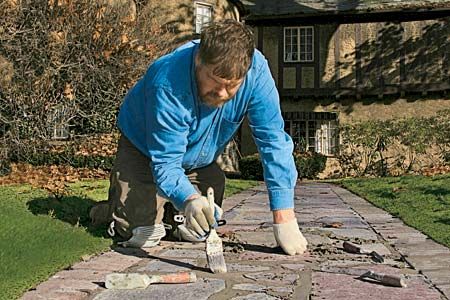Project details
Skill
Cost
Estimated Time
Q: The mortar joints surrounding the stones in my walkway are crumbling. Can they be patched? — Nellie Kurtzman, Mount Vernon, NY
Martin D’Arcy, owner of DNF Construction, replies: A stone walkway with cracked mortar is an eyesore and can become a tripping hazard if water gets underneath and loosens the stones.
Repairing Mortar in a Stone Walkway
“The best way to repair walkway mortar joints is with a sand-topping mortar mix, which is stronger than regular mortar and can handle wider joints,” says D’Arcy. “I mix it with an acrylic fortifier so that the joints will be less susceptible to water penetration.”
“The hardest part of this job is chipping out the crumbly old mortar without damaging the stones. Once the old stuff is out, filling the joints is as easy as decorating a cake. Just keep in mind that while the new mortar won’t match the existing mortar color, it will lighten and blend in over time. The only way to get the same shade would be to replace all the old mortar, crumbling or not. Tackle this job only when there’s no danger of frost. A dip below freezing can ruin fresh mortar.”
Materials and Tools Needed To Repair Stone Walkway Mortar
Before you get started, gather the following tools and materials:
- Dry mortar mix
- Acrylic fortifier
- Safety glasses
- Gloves
- Kneepads
- 3-pound sledgehammer
- Masonry chisel
- Masonry brush
- Paintbrush
- Sponge
- Brick trowel
- Grout bag
- Pointing trowel
- Mortar tub
Stone Walkway Joint Repair Process
Repairing the mortar joint takes about a day’s worth of chiseling, mixing, piping, and troweling.
1. Chisel Out the Mortar
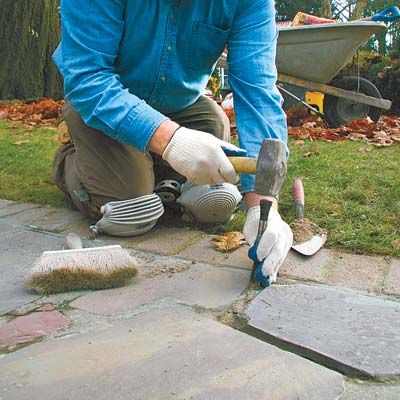
First, you’ll remove the old and crumbling mortar. You’ll want to do this carefully to avoid damaging the surrounding stones. Put on your gloves, safety glasses, and kneepads to protect yourself against any flying debris during the chiseling process. This step can be physically intensive, so take breaks as you need to stay accurate.
Use a cold chisel and 3-pound sledgehammer to carefully break out the crumbling mortar. Chisel right down to the setting bed, but use caution as you go deeper. For particularly stubborn areas, use a grinder with a diamond blade.
Once the old mortar is removed, use a stiff-bristled nylon brush to clean out the joints and remove loose debris and dust. This will help the new mortar bond better.
2. Make the Topping Mix
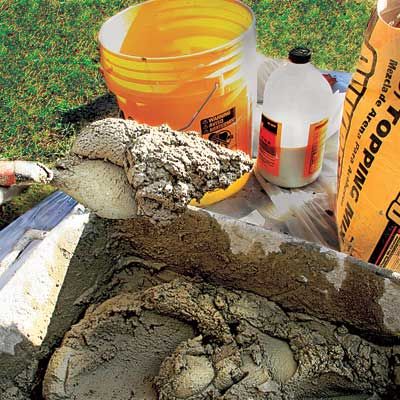
A sand-topping mortar is best for repairs since it’s strong and can handle wider joints. Here’s how to prepare it:
Pour the dry mortar mix into a wheelbarrow or large mixing container. Stir in an acrylic fortifier according to the manufacturer’s instructions. This helps improve the mortar’s water resistance and durability. Then, gradually add water to the mixture, stirring constantly until the mixture resembles peanut butter—sticky but workable.
The mixture will remain workable for about 45 minutes, so don’t mix more mortar than you need for that time.
3. Fill the Joints
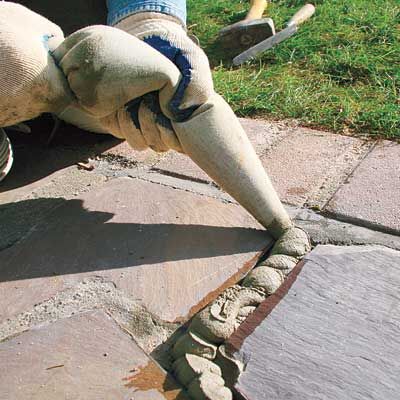
With your mortar mix prepared, it’s time to fill the joints between the stones. Before you do, sponge the stones and joints with water. By “priming” them with moisture first, they’ll be less likely to absorb the moisture from the fresh mortar.
Ladle the mortar into a grout bag or zip-top plastic bag with a 1/2-inch diameter hole cut out from one corner. Starting at one end, squeeze the mortar in a smooth, continuous motion that forces it to the bottom of the joints.
Fill up the joint to a depth of about 1 inch in a single pass, leaving the mortar just above the stones. Deeper joints should be filled halfway, packed down with your trowel, then topped off. If any mortar lands on top of the stones, scrape it off immediately to prevent staining.
4. Trowel the Mortar
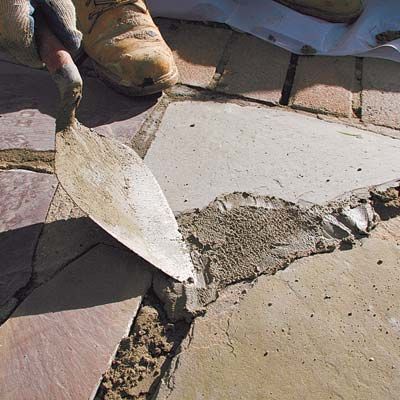
After filling the joints, shape and compact the mortar for a clean finish and professional-grade durability.
Use your brick trowel to push the mortar down into the joints, so it’s well-compacted and free of air pockets. Then, roughly tool it to the same height as the existing joints that surround it. Scrape off the excess mix and dump it back into your wheelbarrow.
As you work, dip the trowel in water to keep it clean and stop fresh mortar from sticking. You should also use a damp sponge to clean any mortar smears from the stone surfaces.
5. Pack it Down
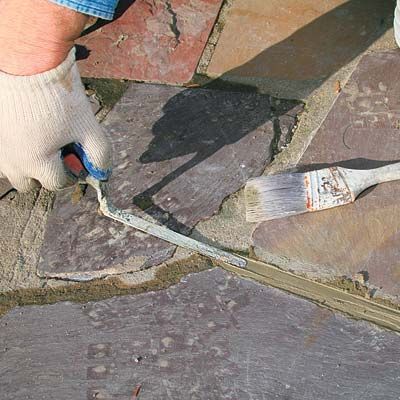
After the initial troweling, allow the mortar to set slightly before the final pack-down. This will give your finished joints a polished look and help prevent future cracks.
Begin this process 60 to 90 minutes after your first filling and troweling. You’ll know that the mortar is ready by pressing down on it with a thumbprint. If the print stays, you’re good to go.
Use a tuck-pointing trowel to smooth and pack down the mortar. Make sure that it matches both the height and profile of your existing joints. Work methodically across the joint and keep pressure consistent to get an even finish.
Keep sponge-cleaning the stone surfaces as necessary to remove mortar residue and prevent staining.
6. Brush the Joints

The final step in the process is to brush the joints. Smooth them over with a stiff, dry, natural-bristle brush. Go in one direction so the texture stays uniform, and remove any small bumps or ridges that the tuck-pointing trowel left behind. The mortar is partially set, so you don’t want to disturb it too much—be gentle but thorough.
After brushing, you can start to put away your supplies. Let the joint continue to cure overnight, and keep foot traffic off the walkway for at least the next day so everything can set properly.
Mortar Curing and Aftercare
Your repaired mortar joint will fully harden in about a week. Even if you think that it’s fully cured, you should still be gentle with it.
Extreme temperatures can make the curing process a bit more complicated. If the weather’s hot, windy, or dry, keep it moist with damp burlap. Likewise, don’t expose the mortar to freezing temperatures, as this can damage it before it’s fully cured.
